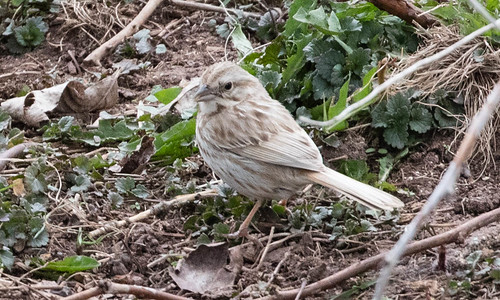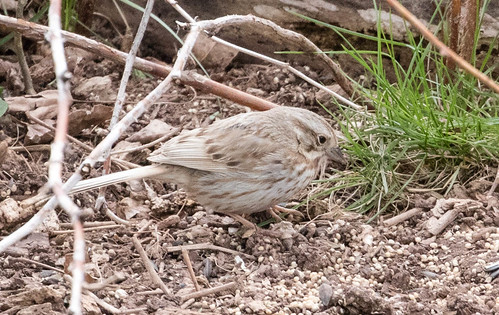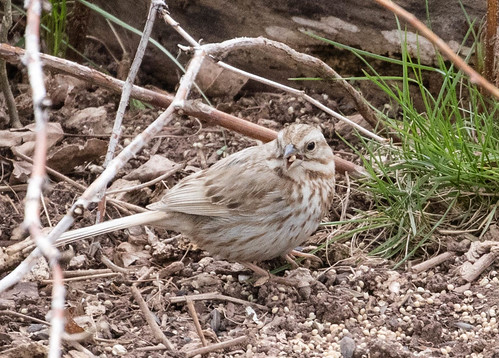Spring is proceeding nice and deliberately this year. The first orioles and hummingbirds have shown up in my neighborhood, but not in big numbers yet. A good assortment of warblers have been arriving, but the vast majority are still Yellow-rumps. The lack of rain lately has dried up the ball field at Park Point, so shorebirds have been few and far between, but I’ve lucked into leading Duluth Audubon’s spring warbler walks at Park Point on two days when Blue Jay migration has been exceptional, with big flocks of jays twinkling past against the blue sky.
I haven’t had many Fox or White-throated Sparrows this year, and not a single White-crowned or Harris’s Sparrow yet. Last week Chipping Sparrows finally supplanted the lingering American Tree Sparrows. I’ve also had a couple of Swamp Sparrows and one Clay-colored Sparrow, even though Peabody Street is the wrong habitat for both. During migration, it really is true that just about anything can show up just about anywhere.
The sparrow I’ve had in the biggest numbers from day to day this spring has been the Song Sparrow. For a while, I’d have as many as four in my sparrow feeding area at the same time, and I’ve been hearing three males singing from different directions a lot. I’ve always had at least one pair nesting nearby, but this year’s three is the best ever.
Last week I had one particular Song Sparrow in my yard that I’d not seen before all spring, and so far I haven’t seen it since. I’d recognize it, because this one is uniquely colored, its plumage extremely pale but not pure white. In ornithology class in the ‘70s, I learned to describe this plumage condition as leucistic; when I started talking to hawk watchers in the ‘80s, I learned it was more properly described as dilute. Meanwhile, in ornithology in the 70s, I learned that birds with patches or almost entirely all-white plumage were partial albinos. Now some scientists say the only proper term for any pale or white bird is also leucistic unless you have solid proof that it produces no melanin at all. They claim the only proper use of the word albino must refer to the genetic condition, and that no genetic condition can be called "partial." That makes leucistic a catchall term for any bird with any low amount of melanin.
I’m not an authority on many ornithological issues—I just try to translate what scientists have agreed on—but in this case, they haven’t really settled on proper terminology even as some have become extremely prescriptive. In my opinion, the words people use, especially words that had a longstanding history of usage since long before anyone had a clue about genetic underpinnings, shouldn’t be retroactively redefined. New information should lead to a more precise but new word, not appropriation of a word that was already perfectly useful with a well-known meaning.
David Sibley was dealing with these same nomenclature rules when he wrote a 2011 entry in his blog. He wrote:
The term leucistic has a confused history. In the introductions of the Sibley Guides I said the term leucistic is synonymous with dilute plumage. That usage was fairly common among birders at the time, and I was unaware that it contradicted several scholarly publications … which define leucistic as the total lack of melanin from some or all feathers (what I called partial albino in the guides). It does make sense to distinguish birds that are unable to deposit melanin (my partial albino, their leucistic) from birds that are able to deposit melanin but only in low concentrations (my leucistic, their dilute). Below I’ve used the term leucistic (not partial albino) for birds which cannot deposit melanin, which helps to distinguish these birds from the narrowly-defined true albino, and allows use of the term “partial albino” as a general category for any bird showing any form of reduced melanin. These terms should be corrected in the introduction of the Sibley Guides.
Unfortunately for me, David Sibley’s use of “partial albino” as the catchall for pale OR patchy-white birds seems just as confusing as “leucistic” is. So I’m giving up on both terms altogether. From now on, I’m calling the condition my Song Sparrow has “unusually pale plumage.” I’ll call what I originally learned as partial albinism “patchy white plumage.” And oddly enough, even though both terms sound less scientific, they’ll have a more obvious and precise meaning than “leucistic" or "partial albino" as they're currently used. Regardless, a rose is a rose is a rose, and any bird with unusual plumage still looks as sweet.


